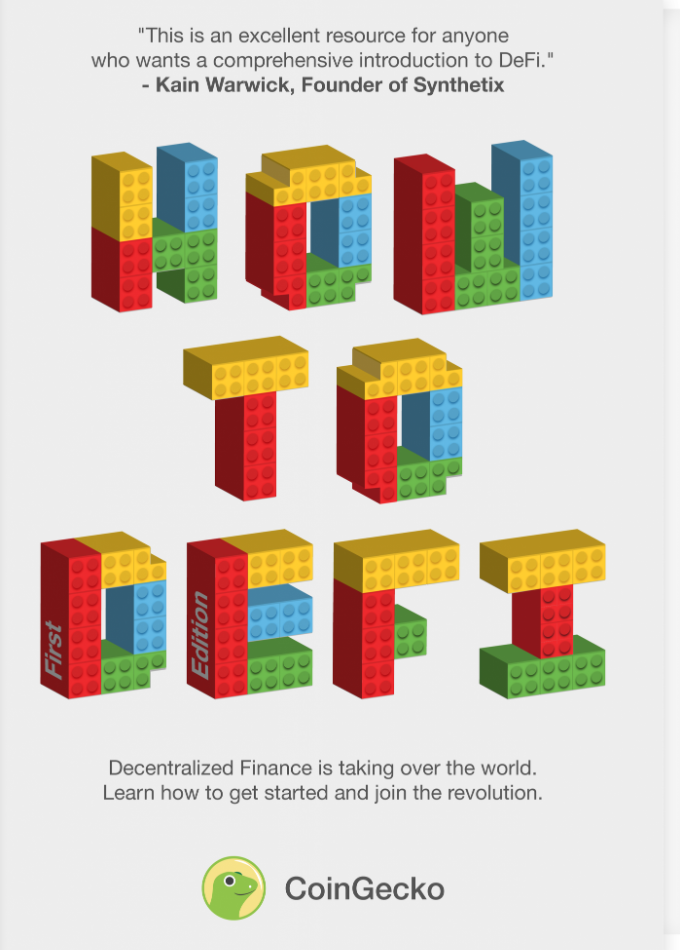Coingecko’s New E-Book “How To Defi” Aims to Simplify Entry to Defi

Coingecko, one of the largest and earliest crypto data aggregators, operating since early 2014, has released a comprehensive e-book on “How To DeFi”, complimentary for download until April 30th.
This is one of the most extensive books on decentralized finance that we’ve seen. It is packed with simple explanations and step-by-step guides to help readers understand and get started within this fast-developing ecosystem.
The CEO of Synthetix has said: ” This is an excellent resource for anyone who wants a comprehensive introduction to DeFi.”
To hear more about what others have said about this book, such as from founders of TokenSets and leading members of Maker, checkout the full book here.
Global Coin Research interviewed co-founder and COO Bobby Ong and the Coingecko team, and asked them for their thoughts behind creating this book. The team highlighted key things to pay attention to in this book and also pointed out some interesting Defi projects in Asia.
- Can you share some background on this book? What inspired you to write this book?
We were following developments in DeFi and wanted to play a role in the ecosystem. However, developments in DeFi seem to be progressing really fast and information was all over the place making it hard even for industry practitioners like us to get started with DeFi. We wished there was a one-stop guide for ourselves to help us navigate the DeFi landscape that was also suitable for beginners.
Since there is no such guide yet, we decided to put our research team efforts together to research the various parts of DeFi and put together a concise and comprehensive step-by-step guide on getting started with the various DeFi applications. This is the first book ever published covering the DeFi ecosystem and we believe it serves as a great introductory material for newcomers and as reference material for the seasoned veterans. - What audience is this book aimed for?
This book is mainly aimed at people with some knowledge of cryptocurrencies but not much knowledge about Decentralized Finance (DeFi). The book provides a basic introduction and step-by-step guides to help users navigate the various DeFi applications. - What do you think are some of the most important parts of this book that readers should pay attention to?
The most important part of this book is the high level overview that we have provided to each segment in DeFi such as decentralized stablecoins, decentralized exchanges, decentralized derivatives, decentralized lending & borrowing protocols etc. We also provide a high-level overview of the key projects in each of these segments for readers to get a better understanding of how things work in DeFi. - You guys have listed projects like Opyn, which was launched very recently, where do you see the Defi space going to?
We believe that DeFi is only at its beginning stage and we have yet to see DeFi reaching its full potential. With permissionless innovation, we will see many DeFi projects coming out in the following years with each project copying, learning, and improving from others in the ecosystem. The ecosystem will only get more complex in the future and we believe it will be important to get a good grasp of the early projects to have a better understanding of how things will develop in the future. We are very excited to see how DeFi will develop and see its future! - Any particular Asia-based defi players that we can get excited about right now
At this point in time, most DeFi projects are Western projects. There are some Asian DeFi projects that are interesting, such as the following:
a) Kyber Network – one of the earliest decentralized applications
b) imToken / TokenLon – imToken is the biggest wallet in China (the Metamask of China) and TokenLon is a fast-growing decentralized exchange. Both run by the same team.
c) Ren Project – allows for decentralized representation of Bitcoin, Bitcoin Cash, and Zcash on the Ethereum blockchain as ERC-20 tokens












